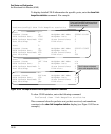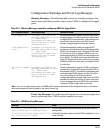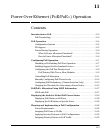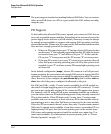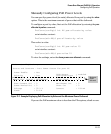
Power Over Ethernet (PoE/PoE+) Operation
PoE Operation
Note The ports support standard networking links and PoE links. You can connect
either a non-PoE device or a PD to a port enabled for PoE without reconfig-
uring the port.
PD Support
To best utilize the allocated PoE power, spread your connected PoE devices
as evenly as possible across modules. Depending on the amount of power the
power supply device delivers to a PoE module, there may or may not always
be enough power available to connect and support PoE operation on all the
ports in the module. When a new PD connects to a PoE module and the module
does not have enough power left for that port:
• If the new PD connects to a port “X” having a higher PoE priority than
another port “Y” that is already supporting another PD, then the power
is removed from port “Y” and delivered to port “X”. In this case the
PD on port “Y” loses power and the PD on port “X” receives power.
• If the new PD connects to a port “X” having a lower priority than all
other PoE ports currently providing power to PDs, then power is not
supplied to port “X” until one or more PDs using higher priority ports
are removed.
In the default configuration (usage), when a PD connects to a PoE port and
begins operating, the port retains only enough PoE power to support the PD’s
operation. Unused power becomes available for supporting other PD connec-
tions. However, if you configure the poe-allocate-by option to either value or
class, then all of the power configured is allocated to the port.
For PoE (not PoE+), while 17 watts must be available for a PoE module on
the switch to begin supplying power to a port with a PD connected, 17 watts
per port is not continually required if the connected PD requires less power.
For example, with 20 watts of PoE power remaining available on a module,
you can connect one new PD without losing power to any currently connected
PDs on that module. If that PD draws only 3 watts, then 17 watts remain
available and you can connect at least one more PD to that module without
interrupting power to any other PoE devices connected to the same module.
If the next PD you connect draws 5 watts, then only 12 watts remain unused.
With only 12 unused watts available, if you then connect yet another PD to a
higher-priority PoE port, then the lowest-priority port on the module loses
PoE power and remains unpowered until the module once again has 17 or
more watts available. (For information on power priority, refer to “Power
Priority Operation” on page 11-7.)
11-6



